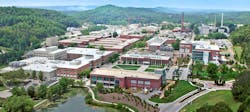U.S. Advances AI Data Center Push with RFI for Infrastructure on DOE Lands
In January, the US government announced its role in the Stargate Project, a government-supported, but privately funded initiative aimed at significantly advancing artificial intelligence (AI) infrastructure in the United States. In February, U.S. Secretary of Energy Chris Wright, traveling with Greg Brockman, co-founder and president of OpenAI, found himself in Oak Ridge, Tennessee.
Possibly inspired by the location, Wright said:
We're at the start of Manhattan Project Two. It is critical, just like Manhattan Project One, that the United States wins this race. We could lose this race in many ways if we don't get energy right. If we don't unleash American energy, we can't win the race for artificial intelligence.
AI Infrastructure RFI
Now, at the beginning of April, the Department of Energy has released its AI Infrastructure on DOE Lands Request for Information. The goal of the document is to get input from industry, grid operators, communities, and other stakeholders to inform potential future solicitations for public-private partnerships to build, operate, and maintain AI infrastructure at DOE sites.
This initiative supports the January 2025 Executive Order titled “Removing Barriers to American Leadership in Artificial Intelligence," aiming to sustain the U.S.'s global leadership in AI and national security. The RFI includes 16 potential sites as examples of where the DOE would like to see these projects located. These sites include:
- Idaho National Laboratory
- Los Alamos National Laboratory
- Sandia National Laboratories
- Argonne National Laboratory
- Brookhaven National Laboratory
- Fermi National Accelerator Laboratory
- National Renewable Energy Laboratory
- Oak Ridge National Laboratory (ORNL)
- Pacific Northwest National Laboratory
- Princeton Plasma Physics Laboratory
- Paducah Gaseous Diffusion Plant
- Portsmouth Gaseous Diffusion Plant
- Savannah River Site Pantex Plant
- Kansas City National Security Campus
While this is just a subset of the large-scale federal research and energy project locations they all share numerous critical requirements for projects of this nature. This includes:
- Access to power and water.
- Security.
- Existing infrastructure.
- Environmental conditions.
- Research and workforce ecosystems.
The sites named already have many of the fundamental components for rapid development of data centers, while some already have next generation nuclear power projects underway.
For example, Idaho National Lab (INL) is the epicienter for ongoing SMR projects in the United States and hosts the Gateway for Advanced Innovation in Nuclear (GAIN) and the National Reactor Innovation Center (NRIC), as well as having a huge about of space and being the home of the original commercial nuclear power research project, EBR-1. Argonne National Lab has a similar history, having been the home of EBR-2 for its 30 years of operation.
In terms of support resources, it can’t be ignored that the top three fastest supercomputers in the world, as of the most recent list, are hosted at US National Labs, including Argonne and Oak Ridge.
Focus on ORNL
Oak Ridge is also the site of the federal Artificial Intelligence Initiative, with Prasanna Balaprakash, ORNL AI Program Director saying:
Oak Ridge National Laboratory has unique expertise and facilities to advance the state of the art in artificial intelligence and apply it to the Department of Energy’s most pressing scientific and national security challenges.
ORNL is also the home of the Center for Artificial Intelligence Security Research (CAISER), which Edmon Begoli, CAISER founding director, described as being in place to build the security necessary by defining a new field of AI research targeted at fighting future AI security risks.
Also, at the end of 2024, Google partner Kairos Power started construction of their Hermes demonstration SMR in Oak Ridge. Hermes is a high-temperature gas-cooled reactor (HTGR) that uses triso-fueled pebbles and a molten fluoride salt coolant (specifically Flibe, a mix of lithium fluoride and beryllium fluoride). This demonstration reactor is expected to be online by 2027, with a production level system becoming available in the 2030 timeframe.
Also located in a remote area of Oak Ridge is the Tennessee Valley Clinch River project, where the TVA announced a signed agreement with GE-Hitachi to plan and license a BWRX-300 small modular reactor (SMR).
On Integrating AI and Energy Production
The foregoing are just examples of ongoing projects at the sites named by the DOE's RFI. Presuming that additional industry power, utility, and data center providers get on board with these locations, any of the 16 could be the future home of AI data centers and on-site power generation. The RFI marks a pivotal step in the U.S. government's strategy to solidify its global dominance in AI development and energy innovation.
By leveraging the vast resources and infrastructure of its national labs and research sites, the DOE is positioning the country to meet the enormous power and security demands of next-generation AI technologies. The selected locations, already home to critical energy research and cutting-edge supercomputing, present a compelling opportunity for industry stakeholders to collaborate on building integrated, sustainable AI data centers with dedicated energy production capabilities. With projects like Oak Ridge's pioneering SMRs and advanced AI security research, these sites offer not only a robust foundation for future AI infrastructure but also an opportunity to advance energy solutions that align with the nation's long-term strategic goals.
In addition to the focus on nuclear and renewable energy sources, natural gas generation also plays a critical role in the energy mix for the RFI sites. Many of the DOE locations are strategically positioned near existing natural gas infrastructure, offering a reliable and flexible power source to complement the ambitious AI data center projects. Natural gas facilities can provide the necessary baseload power and rapid response capabilities that AI workloads require, especially during peak demand periods. With lower carbon emissions compared to coal, natural gas serves as a transitional energy source, supporting the goal of decarbonizing the grid while providing a stable foundation for AI growth. As part of a diversified energy strategy, natural gas could help balance intermittent renewable energy generation, ensuring the continuous availability of power for AI applications, while allowing these sites to remain adaptable to future shifts in the energy landscape.
Conclusion
The integration of AI and energy production on DOE lands will not only support national security and economic growth but also drive innovation at the intersection of artificial intelligence and clean energy. As the initiative moves forward, industry players—including utility providers, energy developers, and data center operators—will play a crucial role in realizing this vision.
About the Author


